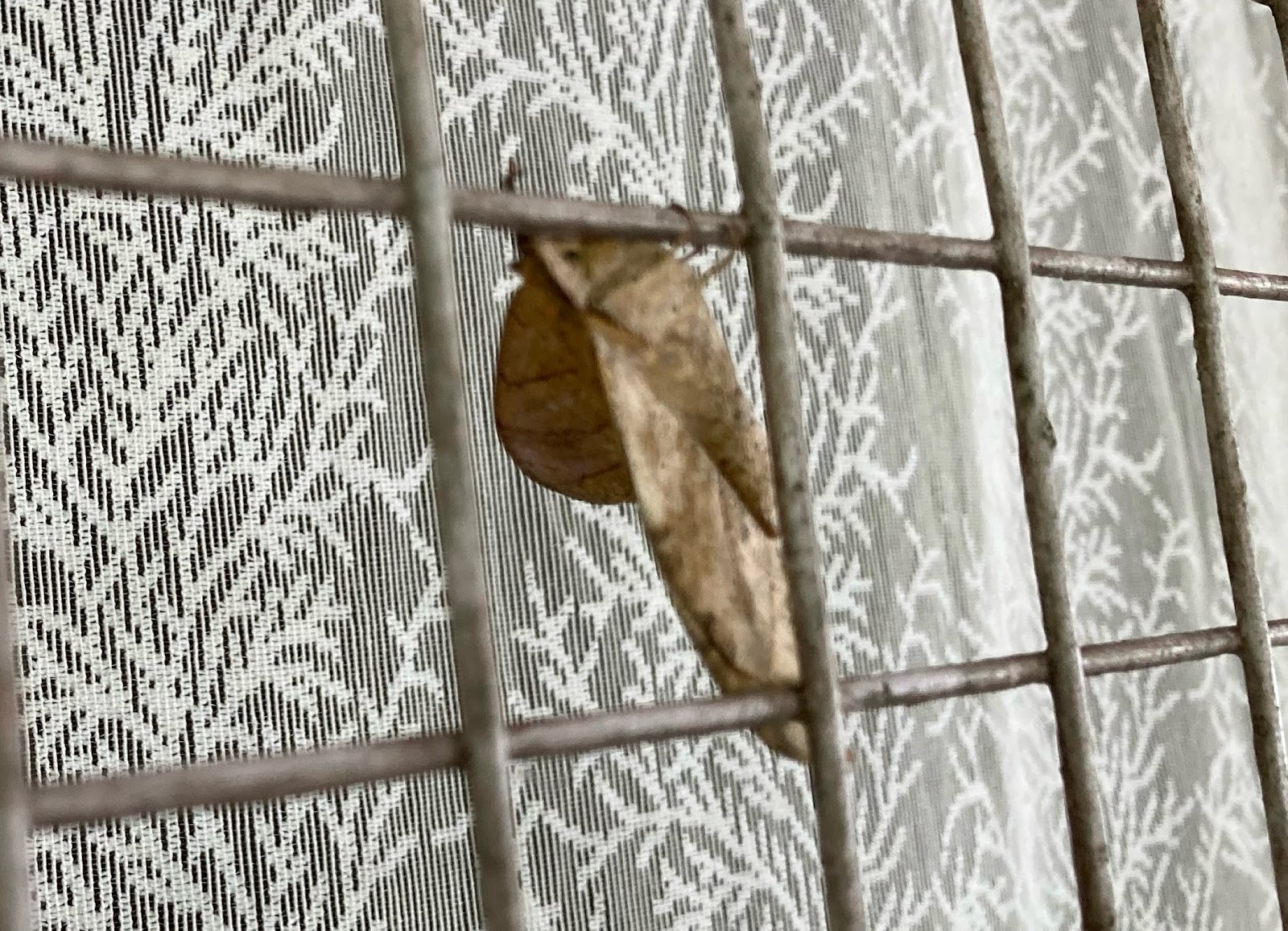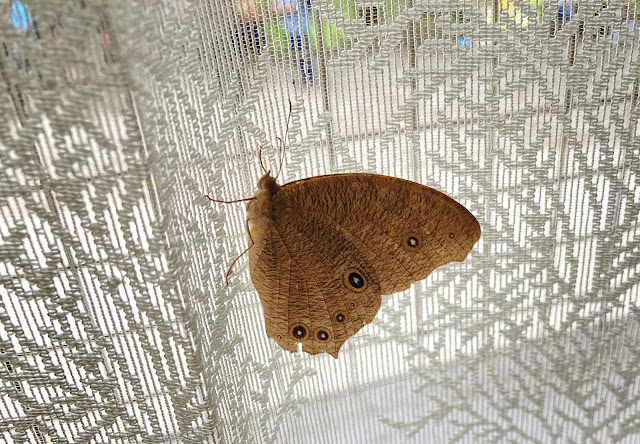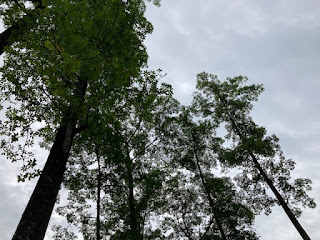Monday, November 7, 2022
Not two, only one species of hoolock gibbon in India: study
Wednesday, November 2, 2022
Day 3 - The moths on lace - at Sally Lake
Oct 3rd 2022
After the avian-dry morning at Jia grasslands, the consensus was for tea at Sally Lake again!
Sally Lake had something besides the tea, we discovered. The dining room curtains were full of resting moths.
Here are the pictures which I shall identify by and by on iNat.
 |
| The LesserAtlas Moth? |
Sunday, October 23, 2022
Visiting the RIWATCH museum at Roing - Day 5
5th October 2022
RIWATCH - Research Institute of World’s Ancient Traditions Cultures and Heritage - is a not for profit, community-based cultural organisation trying to empower local ethnic communities and involve them in sustainable development.
One rainy evening, several of us (following the earlier visit of Yuvan) headed to this museum, around closing time, located in the village of Khinjili, 10 kms from Roing. It was a charming little place, opened in 2009, with artefacts from the community.
To me, it felt a bit like Dakshinchitra, preserving some not-so-old but vanishing cultural artefacts and ways of living of the local communities.
The following is text that was up on the walls of the museum - converted to text by the scan function on the 'phone.
“ Bhismak Nagar
A Major Archaeological Site
Archaelogical artifacts throw interesting insights into our past, life style of our ancestors and traditions. It helps us to peep into their living times and the historical, social, political and cultural conditions of the people. The descriptions & motifs found on artifacts have often helped historians to make valuable discoveries about the lives of societies. They also link us to various aspects of oral history, myths and descriptions in tolklores that have come down to us from generations.
Using carbon dating techniques, scientists are today in a position to determine the age of an artefact and thus help fix the timeline of events and communities. These are from the fort of the Chutia kings and his people who lived during 8' to 10' century at Bhismaknagar and near the river Kundil, between Roing & Tezu. These were obtained during excavations done in 1950 to 80s.
The household items, displayed belong to Amunad tribes. They highlight the wide use of bamboo plant-products and expertise by the communities, to make utensils and household articles. The versatility of bamboo, cane and herbal gums is beautifully visible in the 'Yakhana bamboo basket made waterproof for holding rice ber Mud pots, even when used are cleverly fitted into bamboo structures, to prevent breakage. The use of metal utensils is of a later times, i.e, early decades of 20th century indicating increasing acceptance of household items from the plains of Assam. It also marks the shift in trade-link from Tibetan markets to those of British Indian market: like Sadiya in Eastern Arunachal and Chaiduar in Kameng of artistic and aesthetic sense of the people, even while using bamboo to make artefacts. The butter-tea vessel by Monpas, a community living in high mountains, is not found among any other tribes living across foothills and indicate their instristic skill and need based approach.
 |
"ORNAMENTS
In any society, the ornaments reflect the artisitic advancement attained by its members. eg., the Wancho ornaments are marked by crisp designs with brilliant red and black beads, while blue beads occur prominently in Idu Mishmi and Apatani necklaces. The embellishments and sophistication reflected in the ornaments also enable us to understand the social and trade links developed by that society with the world outside, a valuable clue in historical research. (eg., the presence of a variety of rare stones in
Arunachali ornaments could be traced to their procurement from Tibet during the past centuries.) Unlike in the plains, gold is wholly absent, with silver appearing only from the early decades of 20th century as threading wire and medallions. Metal coins are a prominent item in Digaru & Miju Mishmi necklaces. At an individual level, an onament its features and size, could indicate the rank of a wearer, or his/her status in the society. In the pre-independent days, bracelets and ear rings were huge and heavy, but over the decades, they have shrunk to a shape, currently seen across India. The once common large colourful waist bands too have vanished from daily use, with the arrival of modern education and changes in life style.”
 |
| The mural in the outer space |
 |
| What lovely baskets! Sadly, I did not find anything like this in the markets. |
 |
| Those are teeth of tiger and wild board |
 |
| It was Ayudha Pooja/Durga Pooja day |
 |
"HEADGEAR
Originally evolved as a cover for head against sun and cold, the headgear for many communities also served as an important shield against enemy attack (Idu Mishmi Hat). This resulted in the discovery and use of a variety of very durable bamboo, cane, plant varieties and herbal dyes, and in turn their conservation by each community.
These hats also demonstrate different seasoning techniques of these plant parts, a traditional knowledge, which is under threat of vanishing from the people's memories today. Over centuries, the headgears have emerged into unique entities, with characteristic artistic designs distinct for each tribe. The head gears foundoften decorated with colorful beads (Wagchoos and Notes) and wild boar teeth." |
On my return to Chennai, I mulled over what this museum meant, what the loss of these cultures meant. Left to themselves, communities should be allowed to move on, choose what to keep and what to leave behind isn't it?
Saturday, October 8, 2022
Breakfast at Mayudia Pass
I was all excited that we were going to Mayudia Pass. The views would be gorgeous, I imagined, and Probin assured us that the birding would be exciting.
It was a 4 am departure from the camp and we were to assemble at the 'new petrol bunk' spot.
The day was cloudy and a
Slight drizzle greeted us when we awoke. The mountains were under
Cloud cover. The sparrows on the Yatri Nivas roof were not even awake. Our first departure before dawn!
We started our ascent in darkness and soon I was dropping off. Shamim our driver did not have that luxury. Rain steadily increased as we ascended. Past a completely shut Tiwarigaon. Visibility reduced and we slowed to a crawl.
We reached and crossed the board announcing our arrival and it was pouring. Now what? 😀 we sat huddled in our cars while the birds huddled out of sight. In fact there was no sight of anything.
Out of the mist, the toilet emerged magically and soon we were all darting in and out. Amazingly clean and well ventilated and at the same time non leak proof.
And then the tea shop emerged and 21 MNS members were quickly crowded in, dripping rain ponchos and all. Much hilarity and leg pulling. A black hen and a colourful cock clucked disapprovingly at this intrusion on their space.
The conversation about breakfast of course popped up and then Vijay says it's in Dhananjay's car. Where is dhananjay, he asks. And then remembers the members of the missing car - ay where is Elu and Suresh and doc? Pritam goes looking outside bracing the rain - breakfast is important you see - to see the car go by and everyone waving and smiling at him. Breakfast gone with the wind.
Then the penny dropped for the breakfast car occupants. Oh these others are somewhere dry maybe we should check. And then they also tripped in to the already crowded room. Soon we were all breathing carbon dioxide along with plastic fumes. Like death eaters we had sucked out all the oxygen.
Somehow in a Houdini act breakfast was laid out in this crowded room and even more magically the members got into a-line in this space! Poha egg fried rice and kesari filled our stomachs and cheered us up.
Vijay was optimistic that the rain would stop and we should wait for a bit. I wandered into the warm kitchen, where the locals told us to leave sooner than later to avoid the risk of landslides. Maybe they wanted to be rid of us but we left with alacrity.
The drive back was a bit nervy. Small rocks on the road and water gushing down any possible slope. At one point we had to drive through a 'waterfall'.
The first picture is a waterfall we saw the previous day and the last one is the same one after the rains. Chekopani bridge.
The drizzle continued all day. We wandered into town, bought bamboo baskets and then went for lunch.
Drive for breakfast to myodia. 😀
Thursday, October 6, 2022
Speed dialling and identity confusions
It is raining fish and frogs right now and it is a good time to put some of these stories down as I sit on the verandah of the Camp watching the rain pelt down on the orange orchard below. The river below is completely covered with mist and cloud.
A group are playing the Wilderness game indoors and some Male Elders are discussing politics in the verandah. Arjun had managed the feat of sleeping in an upright chair.
The incident of the Speed Dial buddies
When we went into the CCA only Jio was functioning and if you remember our car was 'lost' and we connected to the others from Arjun's phone to Pritam's Jio number. This sets the context to the story as they now had each other on speed dial more or less.
After the walk, in usual MNS fashion the 25 were spread across a km and progressing at snails pace. The group had to be got together! Arjun called Pritam to talk him that boss we need to hurry up, Jibi Palu says it will get very hot and we have to return. Pritam agreed and at the same time wondered what was going on as he thought Jibi ji was next to him. Hmm maybe Palu is a clan name and so there are several around. The ladies around were smirking making the two highly suspicious. They turned and discovered that they were within 10 steps of each other. Loud laughter chased away any of the remaining birds and sheepish looks of the two gents was quite priceless I am told. So in an area with no or minimal signal they managed this feat.
Doc Ravi and his identity crisis
Now doc has a confusion between Arjun and Ramesh. He nattered away in Tamil leaving Arjun bemused. Next, he looked at Gapi and asked her courteously who her husband was while Arjun stood next to her. I guess he once again thought Arjun was Ramesh!
Adding to the confusions was Latha who kept calling Suresh Ravi much to the former's annoyance.
Thankfully, Sheila was fixed in Doc's memory as his Tirunelveli 'cousin' and I (thanks to Raja's mirch masala) am the fast bowler. So no confusions there.
Wednesday, October 5, 2022
Hollong and hoolocks
Dipterocarpus retusus, commonly known as hollong. State tree of Assam. Favoured by the Hoolocks. These lovely specimens were in the farms adjoining the Jia grasslands.
https://roundglasssustain.com/species/hoolock-gibbons-canopy-hollongapar
Jia grasslands and the missing parrotbills
As we waited, Probin gave us an understanding of the grasses. The main one is Khans grasses also called kahua. flower and fruit parrotbill this is eaten by the parrotbill. Fruit name is kaguri. Saccharum spontaneum (wild sugarcane,)
Nol is elephant grass and Madhuri (Typha) is bulrush. The cotton of the typha is used by parrotbills for nesting. Used as nesting by all birds
I earned that Black throated Parrotbill needs all 3. They feed o the Khans, make nests inthe Typha, using the flower of the Madhuri as nesting material.
This whole habitat of about 5 sq kms supports 3-4 black throated parrot bills!! These birds mate for life, are poor breeders and seem to be under stress from habitat loss. With such a low population, it was no surprise that we didn't see or hear them. We insisted on no playback to attar t these already stressed birds.
Marsh babbler - these we heard. very shy - laju ki dhap in Assamese. Walks on the bunds aka dhap.
We tramped back out to the cars, saw spiders, dragonflies and butterflies along the way.
Checked in on Sekar who seemed to be doing ok with one paracetamol inside.
As we headed back, Probin pointed out the long houses of the Adi tribe, with their sloping roofs and also the side prayer room.
More soon.

Day 18 - the little dot on my sunshade
So much of appreciation and enjoyment these days is because of magnification. This little dot stuck to my sunshade would have been ignored...

-
Sometimes in the quiet stillness of midday, interesting birding things happen on our balcony. Red vented bulbuls (Pycnonotus cafer) - two o...
-
I and the Bird is a carnival celebrating the interaction of human and avian, an ongoing exploration of the endless fascination with birdlife...












































